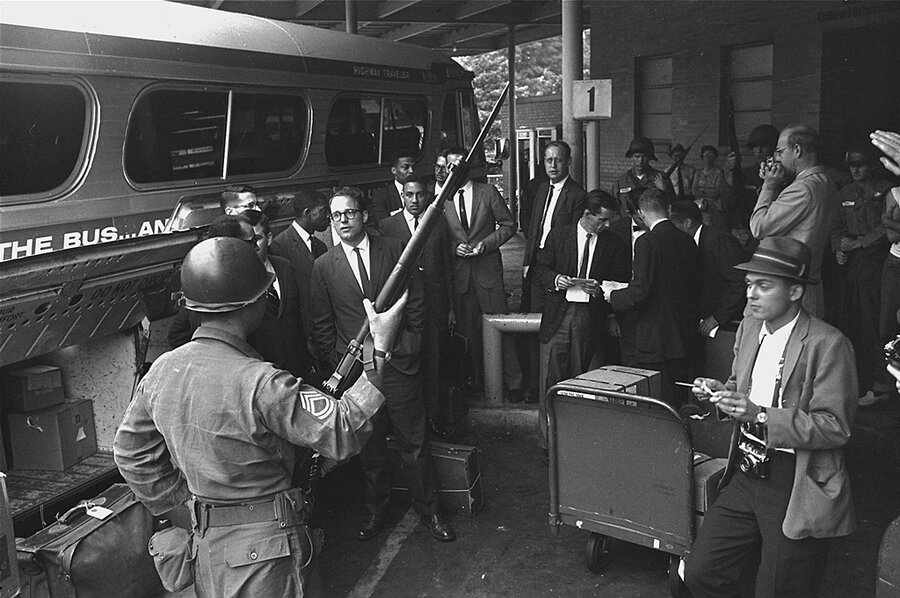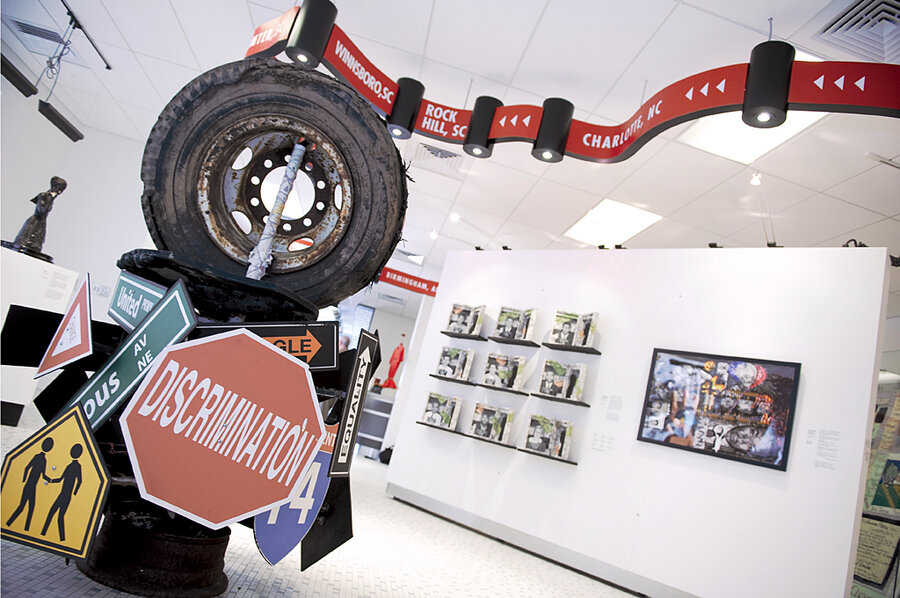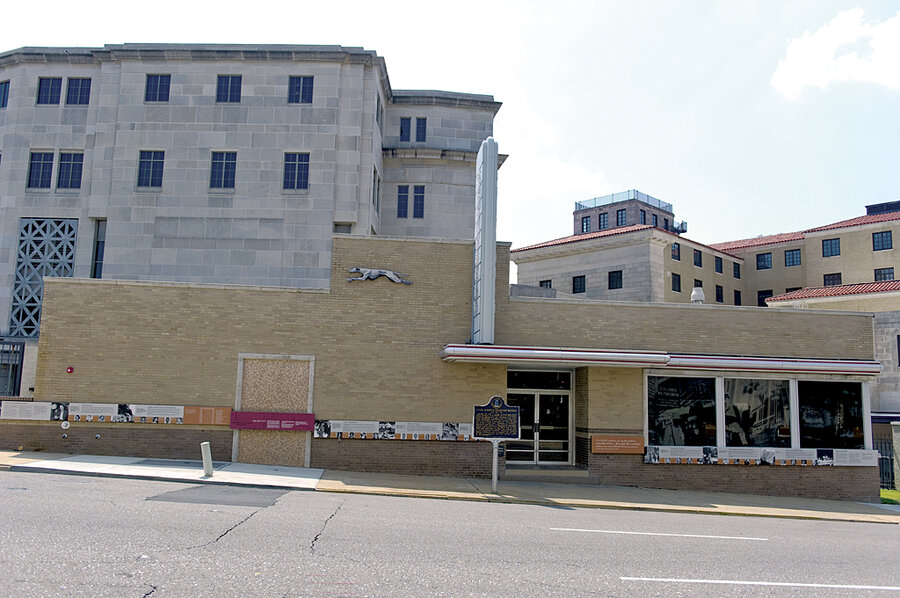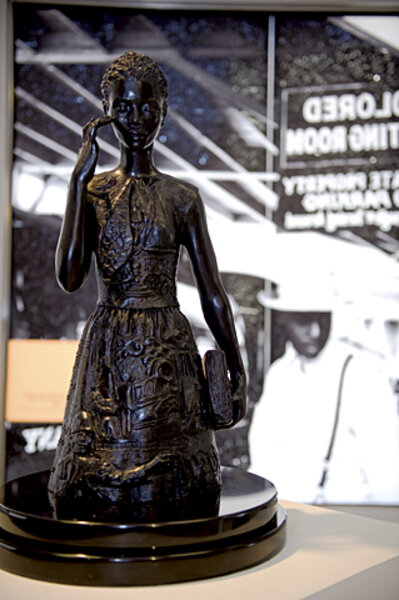In America's Deep South, a front seat for Freedom Riders
Loading...
| Montgomery, Ala.
Fifty years ago, on a hot day in late May, 21 tousled men and women stepped off a Greyhound bus and into the clamor of the Montgomery, Ala., bus depot. They called themselves the Freedom Riders, and for the previous few weeks, they had been hurtling by coach through the American South, from Washington, D.C., to Virginia; from Virginia to North Carolina; and from North Carolina over into Tennessee.
They were students, most of them, black and white, 20- and 30-somethings, schooled in the ways of nonviolent protest and encouraged by the recent success of the Greensboro, N.C., lunch counter sit-ins. Their aim was to test a Supreme Court ruling banning segregation at bus and railway stations – a ruling that had largely been greeted with a shrug by Southern officials.
The Freedom Riders left Washington on May 4, 1961, and planned to make New Orleans by May 17. They expected resistance. But they did not fully anticipate the sheer scale of the violence that would greet them upon their arrival in the Deep South: In Anniston, Ala., a gang of Klansmen set upon a Greyhound bus, slashing the tires and tossing gasoline through the open windows in an unsuccessful attempt to burn the Freedom Riders alive. In Birmingham, the Klan and the local police commissioner, Bull Connor, reached an accord whereby the Klan received 15 minutes to freely assault the Freedom Riders, without any police intervention. And in the capital city of Montgomery, the Freedom Riders walked through the doors of the bus depot and into the arms of a seething mob.
Dozens were injured, including several Freedom Riders, a few journalists, and John Seigenthaler, a Justice Department official dispatched, belatedly, to Alabama by Attorney General Robert Kennedy. An image of a battered Freedom Rider named Jim Zwerg, clad in a suit and tie, bleeding freely, became an iconic symbol of the Civil Rights Era. As did the Freedom Riders themselves: At a time when the federal government would have preferred to ignore the racial strife building in towns such as Montgomery, a small group of dedicated young people risked bodily harm to bring that conflict front and center.
Now, a half century after the Freedom Riders first arrived in this city, the Montgomery bus depot has been converted, with the help of the Alabama Historical Commission and historians, such as Raymond Arsenault, into the Freedom Rides Museum – a timely monument to a groundbreaking journey.
In fact, says Dr. Arsenault, the John Hope Franklin professor of Southern history at the University of South Florida, St. Petersburg, and the author of a critically acclaimed book on the Freedom Riders, it is no stretch to say that the protests in Alabama helped change the tone for the racial equality movement as a whole.
"It really took the struggle out of the courtroom, and into the streets – it helped convince other people that direct action was needed," Arsenault says. "Even today, people are still astonished by the physical and moral courage of the Freedom Riders."
Arsenault adds: "For us, in the 21st century, the idea that the Freedom Riders put their bodies on the line for a principle, it restores our faith in the idea of personal empowerment."
The Freedom Rides Museum is small and square – not much more than a single room. Unlike traditional museums, it is open just two days a week, Fridays and Saturdays, from noon to 4 in the afternoon. The first exhibition, which was unveiled at a grand opening in May, comprises original works from 15 artists, along with a "story" quilt devoted to the Freedom Riders, and a three-dimensional map displaying the path taken by the Freedom Riders. Still, the modest scale of the museum belies the intense behind-the-scenes struggle over the fate of the building itself.
Through the 1980s, the Greyhound station sat empty – sections were destroyed and carted away, or else incorporated into surrounding structures. Then in 1990, the city announced it would demolish the entire station to make way for a vast new courthouse.
"We were extremely worried that they were going to demolish the entire thing," says J. Mills Thornton, a professor of history at the University of Michigan and an early supporter of the Freedom Rides Museum. "It was highly, highly endangered. That worried us, because if you destroy this building, you destroy the context, and no one will get a sense of the events that occurred here."
Eventually, with the help of several Montgomery officials – among them federal district court Judge Myron Thompson – and the Alabama Historical Commission, the station was saved, mostly. The original facade remains, along with the door reserved for whites. (The "colored" entrance and the back corridors are gone.) But the real dynamism of the museum comes from the art within it – the installations, canvases, and sculptures, which give a vibrant face to the history of the movement.
"I want them not to forget. It comes down to that," says Kevin Cole, an artist based in Georgia. Mr. Cole donated an installation work to the Freedom Rides Museum depicting neckties – a reference to a "necktie party," or a lynching – and a map of the southern United States, decorated with black-and-white portraits of civil rights leaders. The pieces, dubbed "Colorless Dreams," are a reminder, Cole says. "I hope people will understand what actually occurred, and how far we've come. And how far we have to go."
Katherine Strause, an artist based in Arkansas, submitted several canvases to the museum, including a painting of the firebombing in Anniston. Ms. Strause says the work is "for all of us, to be reminded of how much we're capable of. I think it's really important, especially now, to revisit the idea of nonviolence," she adds. "Once in a while, these really smart people pop up, and they move society forward. People like this. I actually got to be there at the opening with a lot of the Freedom Riders. And it was such an honor to be a part of this. A small part. Because the museum is something bigger than about my work. It's really about their work."
In this way, the Freedom Rides Museum can be seen as part of a recent surge in memorials to the civil rights pioneers, which began in the early 1990s with the National Civil Rights Museum, in Memphis, Tenn. Since then, a National Voting Rights Museum was built in Selma, Ala.; a Civil Rights Institute went up in Albany, Ga.; and a National Historical Voting Rights Trail has been inaugurated on the long asphalt corridor between Selma and Montgomery. Meanwhile, in St. Augustine, Fla. – another major mecca of the Civil Rights Era – several groups are attempting to raise funds for a 12,000-square-foot Civil Rights Museum.
"There is a really big move afoot – a tremendous interest in getting this kind of commemoration," says Arsenault, the professor of history. Every year, Arsenault leads students on a tour of the South, and "every year," he says, "there is more to see. More monuments, more historical sites." That makes sense, he adds. "So many people today feel overwhelmed by the complexity of the social problems around them, by the state of the world, and they shrug their shoulders, and say, 'Well, what can I do?' And then we see these historical examples. And it inspires us."








